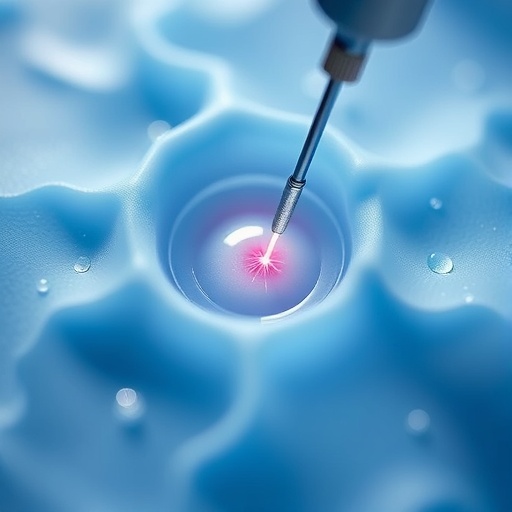In a groundbreaking study poised to change the landscape of surgical techniques, researchers from China have unveiled a novel waterjet-based cutting system that promises low-trauma separation of various soft tissues. This innovative approach is particularly relevant for complex surgeries where precise tissue manipulation is critical for optimal patient outcomes. By leveraging the unique properties of water jets, the research team aims to significantly reduce the risks associated with traditional cutting methods, such as scalpel surgery.
Waterjet technology has long been employed in industrial applications due to its ability to cut through materials cleanly and efficiently without the heat associated with traditional cutting tools. The essence of the technique lies in the high-pressure water stream that can be finely tuned for different applications, ensuring a precise interaction with the target tissues. This mechanical performance offers a key advantage in surgical settings where minimizing damage to surrounding structures is paramount.
The researchers conducted a series of experiments to understand the tissue-selective separation mechanisms facilitated by waterjet impact. Their findings revealed that the effectiveness of waterjets varies significantly across different types of soft tissues, including muscle, fat, and nerve tissues. By analyzing these differences in response to waterjet impact, they could design a cutting strategy that optimally balances cutting efficacy with tissue preservation.
Central to the success of this technique is the ability to adjust the waterjet parameters based on the specific type of tissue being targeted. Factors such as pressure, nozzle design, and the angle of impact were meticulously analyzed. The team discovered that these adjustments not only improved the precision of the cut but also significantly decreased the trauma caused to adjacent healthy tissues. This discovery holds tremendous potential for enhancing surgical precision, especially in delicate operations involving vital organs.
In addition to the mechanical aspects of waterjet cutting, the research underscores the importance of understanding biological interactions at play during the cutting process. The study offers insights into how waterjets can inadvertently affect the morphology and physiology of tissues. By investigating these interactions, the researchers have laid the groundwork for a more refined approach that capitalizes on the benefits of hydro-surgery while minimizing potential detriments.
The implications of this research extend beyond the realm of pure mechanics. Surgeons in various specialties, from orthopedic to cardiovascular, stand to benefit from this technology that can transform their surgical practices. The ability to perform procedures with reduced trauma may lead to faster recovery times, fewer postoperative complications, and an overall enhanced patient experience. As healthcare systems continue to prioritize patient-centered care, technologies that align with these values are poised for rapid adoption.
The study’s findings also open avenues for further exploration and innovation in surgical techniques. The adaptability of waterjet technology may inspire new tools and devices designed specifically for nuanced surgical applications, pushing the boundaries of what’s possible in minimally invasive surgery. As the medical community investigates the practical applications of this technology, the overall landscape of surgical procedures could dramatically shift towards greater precision and safety.
Furthermore, the research highlights the necessity for interdisciplinary collaboration between engineers, biologists, and medical professionals to fully realize the potential of such innovative technologies. This cooperation can enhance the development of customized waterjet systems that cater to specific surgical needs, ultimately fostering a new paradigm in the surgical field. By merging technical expertise with medical insights, the researchers aim to create devices that not only perform efficiently but also integrate seamlessly into surgical workflows.
As the research gains traction, discussions around regulatory pathways and clinical trials will become increasingly pertinent. Ensuring safety and efficacy in human applications requires rigorous testing and validation in clinical environments. Collaborations with hospitals and surgical teams will be crucial for navigating these complexities, ensuring that innovations translate into tangible benefits for patients.
Looking forward, the potential applications of waterjet cutting in various medical fields could reshape surgical methodologies fundamentally. From enhancing minimally invasive approaches to pioneering entirely new techniques, the boundaries of surgical intervention may expand significantly. This groundbreaking research signifies a foray into an era where precision medicine may reach new heights driven by technological advancements.
In conclusion, the emergence of waterjet-based surgical techniques, as elucidated by Zhao et al., presents a pivotal moment in the evolution of surgical practices. By marrying cutting-edge engineering with intricate biological understanding, the potential of this innovative approach is vast. As researchers continue to refine this technology, the overarching goal remains clear: to enhance surgical precision while safeguarding patient wellbeing, paving the way for a future where trauma in surgery becomes a concern of the past.
Subject of Research: Tissue-selective separation mechanism using waterjet technology for soft tissue surgery.
Article Title: Tissue-Selective Separation Mechanism of Multi-type Soft Tissues Under Waterjet Impact for Low-Trauma Cutting Surgery.
Article References:
Zhao, J., Song, XF., Wei, X. et al. Tissue-Selective Separation Mechanism of Multi-type Soft Tissues Under Waterjet Impact for Low-Trauma Cutting Surgery.
Ann Biomed Eng (2025). https://doi.org/10.1007/s10439-025-03801-3
Image Credits: AI Generated
DOI: 10.1007/s10439-025-03801-3
Keywords: Waterjet technology, soft tissue surgery, low-trauma cutting, tissue-selective separation, minimally invasive surgery.




